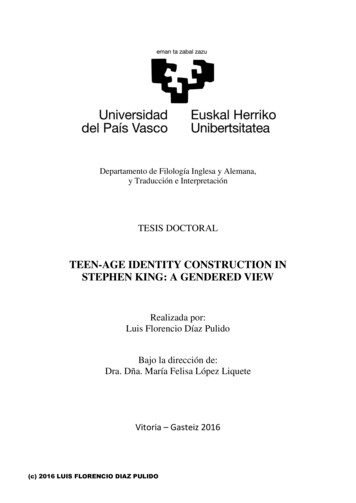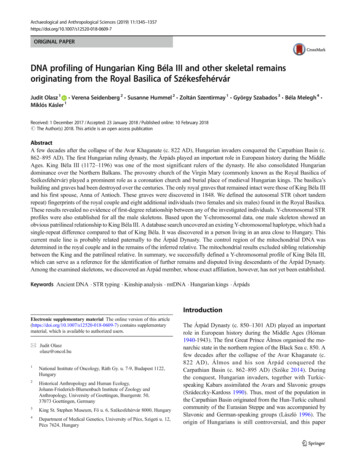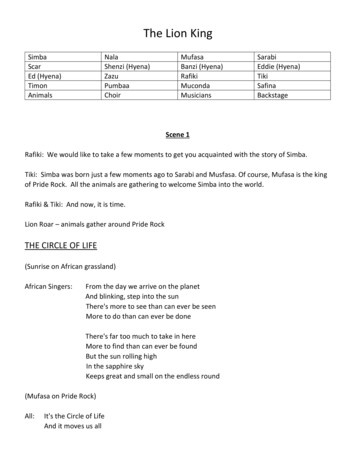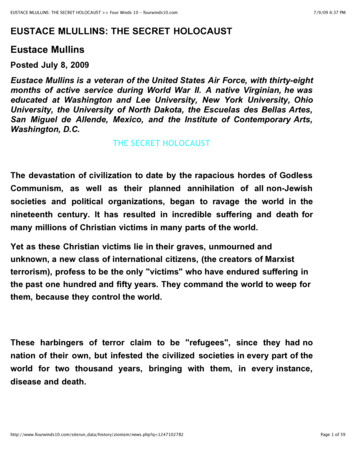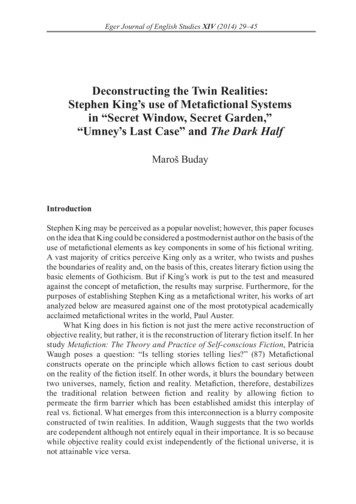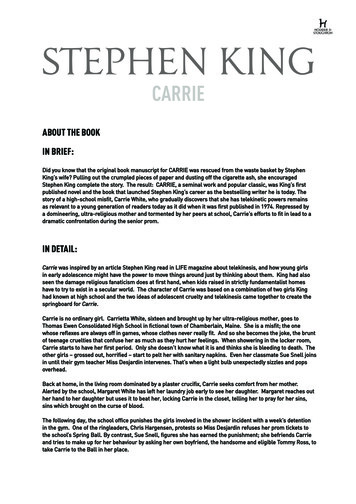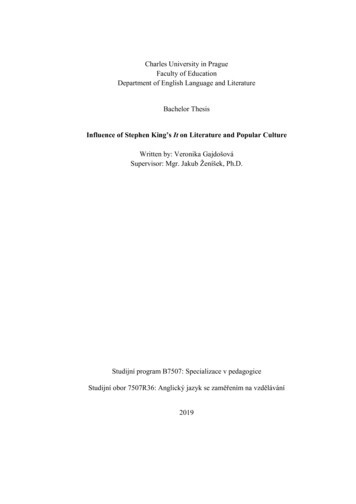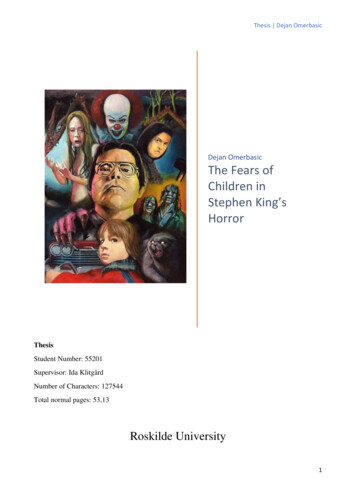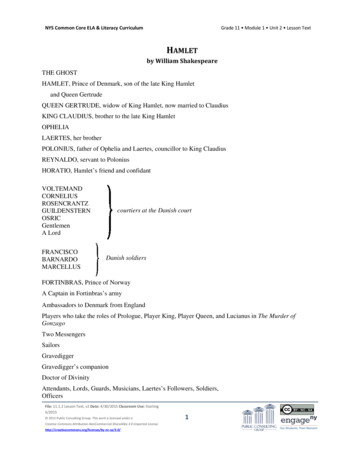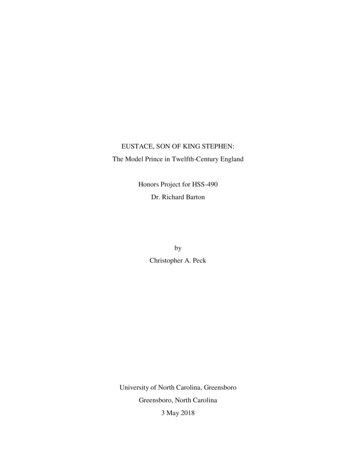
Transcription
EUSTACE, SON OF KING STEPHEN:The Model Prince in Twelfth-Century EnglandHonors Project for HSS-490Dr. Richard BartonbyChristopher A. PeckUniversity of North Carolina, GreensboroGreensboro, North Carolina3 May 2018
Peck 1In 1152, King Stephen of England pressed Archbishop Theobald of Canterbury to crownhis son, Eustace, as king of England during his life time.1 This action was explicitly forbidden bythe Pope in a letter, and served as the final rebuke to Eustace and his father, before Eustace’sultimate death in August, 1153. As the count of Boulogne and the elder son of King Stephen,Eustace has been unduly overlooked by historians. The historical significance attributed to thepreceding and succeeding reigns of Henry I and Henry II have loomed very large in historicalcontexts, and have overshadowed Stephen’s reign, helping to diminish Eustace’s historicalvalue.2 Eustace does not need to be painted as a failure, but he can easily be described assomeone who, like his father, ultimately ended on the bottom of the wheel of fortune. UnlikeEustace, his rival, Duke Henry of Normandy (Henry II), was able to have his own son, Henry theYoung King, crowned during his lifetime at age 15 in 1170.3 Stephen lacked the political capitalto obtain this act for his own son. This can be attributed to the rival claim of Empress Matildaand her son – a political position some chroniclers and clergymen chose to support due to theirdistaste for Stephen or simply as an alternative to Stephen’s lordship. Though he was notcrowned and is not as historically significant as his father or their Plantagenet rival, Eustace is anundervalued figure whose life merits consideration since he can provide insight into largerhistorical trends.This essay examines the deeds and assesses the life of Eustace. It considers the opinionsof contemporary sources and offers a juxtaposition between Eustace and the princes of the1Henry of Huntingdon, Historia Anglorum: 1000-1154 (New York, NY: Oxford University Press, 2009), 92.Gervase of Canterbury, The Historical Works of Gervase of Canterbury, 2 vols. trans. William Stubbs, (London,UK: Longman & Co, 1879), 155.2Heather J. Tanner, “Henry I’s Administrative Legacy: The Significance of Place-Date Distribution in the Acta ofKing Stephen” in Henry I and the Anglo-Norman World: Studies in Memory of C. Warren Hollister (Woodbridge,UK: Boydell Press, 2007): 183-199; Emilie Amt, The Accession of Henry II in England: Royal GovernmentRestored 1149-1159 (Woodbridge, UK: Boydell Press, 1993), 15.3Matthew Strickland, Henry the Young King: 1155-1183 (London, UK: Yale University Press, 2016), 78-79.
Peck 2succeeding and preceding reigns. Eustace is frequently cited by contemporary sources as anignoble, irreligious figure.4 Although Eustace did not display all the attributes of a model princein the eyes of the clerical men who wrote the chronicles, these same men frequently describedhim as a man of valor and a magnificent warrior. He is portrayed with a similar likeness and ashaving similar character traits as his father. Both Stephen and Eustace were referred to as menlacking in civility and decency, but rarely were they said to be lacking in the areas of personalvalor or attributes worthy of a King. This essay will argue – firstly through a survey of the life ofEustace, and secondly through closely analyzing and juxtaposing his most important deedsagainst those of his rivals – that Eustace, out of the three prematurely deceased princes oftwelfth-century England, embodied the characteristics of a model prince most of all. The idealprincely characteristics assigned to Eustace allow us to use his life to contribute to largerhistorical queries such as: What were the chronicler’s thoughts on princely anger? What is therole of a prince? What makes a good prince?Remarkably, the twelfth century in England witnessed a situation whereby three princesdied before they could ever become King. These three were William Atheling, the son of HenryI, Eustace, son of King Stephen, and Henry the Young King, son of Henry II. 5 Of these threeprinces, Eustace is the only one who can be characterized as a model prince. He indeed has hisflaws, as is well documented by the chroniclers, but his overall image is most congruent with the4Henry of Huntingdon, Historia Anglorum, 92; William of Newburgh, The History of English Affairs, 2 vols. trans.P.G. Walsh and M.J. Kennedy (Warminster, UK: Aris & Phillips, 1988), i. 125; Gervase of Canterbury, TheHistorical Works, 155; John of Hexham, The History of the Church of Hexham, by John the Prior trans. JosephStevenson (Flinfach, Wales: Llanerch Publishers, 2000), 27-29.5Orderic Vitalis, The Ecclesiastical History of Orderic Vitalis, Vol. vi, ed. and trans. Majorie Chibnall (London,UK: Oxford University Press, 1978), 296; The History of William Marshal 3 vols. ed. A.J. Holden trans. S. Gregory(London, UK, 2002), i. 350-351. Gesta Stephani, ed. trans. K.R. Potter (London, UK: Oxford University Press,1976), 238-239.
Peck 3princely ideals and characteristics of an aristocratic youth during this century.6 In order to derivewhat is meant by princely characteristics, one must conclude that prince-hood is actually apreparatory process – a lord in training – for the position that is the ultimate goal of any prince:king. Thus, the characteristics of an ideal king and the tenets of kingship can be mutuallyemployed in order to create a framework that is apt for the historical consideration of princelynorms.The thoughts on what qualifications make a king good were not very dissimilar from onechronicler to another during the twelfth century. Thanks to how frankly chroniclers wrote, theirwork can be analyzed while taking into account their personal biases, to construct a generaloverlapping framework of their ideas on what made a man suitable to be king.7 By the dawn ofthe twelfth century, several components were almost universally employed by the chroniclers tomeasure the success of a king: justice, charity – specifically towards the church –, fiscal andgovernmental success, chivalrous personality, and the evidence of his divine favor.8 While someGeorge Duby, “Youth in Aristocratic Society” in The Chivalrous Society (Berkeley, CA: University of CaliforniaPress, 1980), 112-122.7Björn Weiler describes the qualities of good kingship in his article as “the rigorous pursuit of justice, generousendowment of religious houses, and meticulous handling of financial matters.” Heather Tanner follows aCarolingian Blessing called the Prospice to form her tenets of kingship, which she lists by saying that a “king mustbe the mightiest protector of his churches and monasteries, a staunch keeper of the peace, a magnificent benefactorof ecclesiastics, and a generous and loving patron to the magnates and faithful men of his realm.” I have decided,keeping their lists of attributes in mind, to form my own qualifiers which are not dissimilar but additionally includea sense of personal worthiness which I encapsulate through “chivalry” and through “divine favor.” See BjörnWeiler, “William of Malmesbury, King Henry I, and the Gesta Regum Anglorum” Anglo-Norman Studies XXXI:Proceedings of the Battle Conference 2008, (2009): 166; Heather J. Tanner, “Trial by Chronicle – Assessing theFailures of Three Rulers of England and Normandy: 1170-1300,” Majestas 4 (1996): 39-60. For information on theevolution of European medieval kingship see: Henry Allen Meyers, Medieval Kingship (Chicago, IL: Nelson Hall,1982).8While chivalry as a code of conduct was not fully formed by the twelfth century, it was undergoing drastic changesduring this period. The tenets which became chivalry already existed, but did not form into the doctrine or codehistorians consider it as today until later in the thirteenth century. For information on the tenets of kingship see:Björn Weiler, “William of Malmesbury, King Henry I, and the Gesta Regum Anglorum” 165; Heather J. Tanner,“Trial by Chronicle – Assessing the Failures of Three Rulers of England and Normandy,” 40-41. For further readinginto chivalry see: H.A Meyers, Medieval Kingship, 2, 18, 188; David Crouch, “Chivalry and Courtliness: CollidingConstructs” in Soldiers Nobles and Gentlemen: Essays in Honour of Maurice Keen (Rochester, NY: Boydell Press,2009); David Crouch, “From Preudommie to Chevalerie” in The Birth of Nobility: Constructing Aristocracy in6
Peck 4of these elements cannot be wholly applied to princes since they are not fully kings, most ofthese aspects can be entirely dissected, their rank notwithstanding. Eustace, for example, isfrequently cited by hostile medieval chroniclers as lacking in his Christian moral obligations.However, arguments will be marshalled in this essay to challenge that seemingly ubiquitousclaim. Henry the Young King, on the other hand, might seem to be a better model prince basedon his elegance and temperament alone. That is, he might seem to be a model if he had not goneagainst his father and family, and had not in his attempts to subvert royal law and authoritycaused a civil war.9 The comparison of Eustace and Henry the Young King, two princes whowere equally unable to secure the long-term role as king for themselves, will prove extremelyprofitable for an expository review of the suitability of either one for the throne. Henry theYoung King has a significant amount of both contemporary and modern writings which considerhis aptitude, characteristics, and deeds, unlike Eustace, who has no sources considering theseaspects of his life. Therefore, in order to more fully understand Eustace’s placement andconnection to the framework of kingship, the deeds of his life up until his premature death mustbe evaluated, and the best efforts to impartially grasp who he was as an individual must be made.The Deeds of Eustace, count of Boulogne and son of King StephenEustace is presumed to have been born in 1130, but unfortunately there is no directdocumentation or evidence dating his exact birth year. He came from illustrious families on bothhis maternal and paternal sides; he was a true aristocrat through and through. Though not yetking of England, Eustace’s father, Stephen, was already both the count of Mortain, and the countEngland and France, 900-1300 (London, UK: Routledge, 2014). John Gillingham, “Conquering the Barbarians:War and Chivalry in Twelfth-Century Britain” The Haskins Society Journal Vol. 4 (1992).9See Matthew Strickland, Henry the Young King, 151-154.
Peck 5of Boulogne, as well as being a member of the Thibaudien comital dynasty of Blois. Mortain wasa county given to Stephen by his maternal uncle, King Henry I, from the king’s personaldemesne.10 The county of Boulogne was obtained for Stephen through his marriage, which wasalso arranged by Henry I as personal favor for one of his favorite nephews. Eustace’s mother,Mathilda of Boulogne, was the heiress to the county of Boulogne as she was the only child ofEustace III of Boulogne, and his wife, Mary (sister to Mathilda II, queen of Henry I).11 Boulognewas a highly desirable county due to its wealth. Not only did it encompass the lucrative port cityof Boulogne on the coast of Normandy, it also entailed significant landed estates in England, theso called “honor of Boulogne.”12 It is calculated that at the time of the creation of the DomesdayBook, Boulogne and all its honors were valued at 770, making it the eleventh most valuableholding listed.13 Although the value is estimated to have decreased by the mid-1120s, due to thedestruction of property, the acquisition of Boulogne for Stephen was still able to propel him intoa position of importance as a major landholder in England. Eustace, as the older of Stephen’s twosons, would then benefit from this same title when in 1147, at the age of sixteen or seventeen,Eustace was granted the title of count of Boulogne.14Eustace first appears on the scene in the written record in a major way in 1136, shortlyafter Stephen’s coronation in December, 1135. Eustace attested to and signed a total of six10William of Malmesbury, Historia Novella ed. Edmund King, trans. K. R. Potter (New York, NY: Oxford Press,1998), 98-99.11Orderic Vitalis, Gesta Normannorvm Dvcvm vol. ii. ed. and trans. Elisabeth M. C. Van Houts (New York: NY:Oxford University Press, 1995), 262-263.12For a record of land holdings see Domesday Book: A Complete Translation ed. and trans. Ann Williams and G. H.Martin (Bath, UK: Penguin Books, 1992).13Edmund King, King Stephen (New Haven, CT: Yale University Press, 2010), 20.14Eustace was the oldest of Stephen’s children, born in 1130c. William, Stephen’s second son was bornapproximately four years later in 1134c. For information on Eustace becoming the count of Boulogne see GestaStephani, 208-209; For information on William, son of King Stephen, see Edmund King, King Stephen, 141; EarlyYorkshire Charters: The Honour of Warenne vol. viii, ed. Charles Travis Clay (Wakefield, UK: The West YorkshirePrinting Co., 1949), 14-17. For information on the county of Boulogne see Heather J. Tanner, Families, Friends,and Allies: Boulogne and Politics in Northern France and England, c. 879-1160 (Boston, MA: Brill, 2004).
Peck 6charters at the young age of either five or six at the 1136 Easter court at Westminster.15 It issignificant that Stephen held his early courts at Westminster and not elsewhere, such asWinchester, the typical site for King Henry and the Anglo-Norman kings. Westminster’s newrole established the importance of London to Stephen’s reign as the new center of his kingship,something that is well evidenced through the charters of both Stephen and Eustace.16 BothWestminster and Eustace were on display through these early charters as prominent andpermanent features of Stephen’s newly formed government. There were many reasons whichwarranted Eustace’s presence at court, in spite of his youth. Firstly, as a new king, Stephen tookthis moment to make more specific provisions of restorations and grants to important individualsduring this time. These were in addition to his numerous charters from 1135, which provided theexpected general confirmations.17 No doubt a secondary objective for Stephen was to includeEustace in his kingship from an early date.18 Stephen needed to firmly establish Eustace’s statusas heir and prince who was hopeful of succession – if only to help avoid the circumstances whichStephen himself had capitalized upon in order to become king. Having Eustace involved was asuccessful first step in this plan that Stephen hoped would ultimately lead Eustace to the throne.To his dismay, Eustace’s path was continually blocked at every turn by church leadership and thePope, Empress Matilda, and clergymen throughout England over the next decade and a half.1915Regesta Regum Anglo-Normannorum 1066-1154 vol. iii, ed. H.A. Cronne, R.H.C. Davis (Oxford: ClarendonPress, 1968), nos. 341, 204, 945, 946, 947, 948.16Ibid.17Stephen’s Charters of Liberties trans. Richard Barton, 2013.18David Crouch, The Reign of King Stephen: 1135-1154 (Harlow, UK: Pearson Education Limited, 2000), 42.19John of Salisbury, Historia Pontificalis, ed. and trans. Majorie Chibnall (New York, NY: Thomas Nelson andSons: 1956), 83-86; Henry of Huntingdon, Historia Anglorum, 88; Gervase of Canterbury, The Historical Works, i.150, ii. 75-76.
Peck 7The real years of importance for Eustace of Boulogne began around 1140 with hisbetrothal to Constance, the daughter of Louis VI.20 Henry of Huntingdon suggests that Stephenpaid a dowry to the French King for Constance’s hand in marriage with the money that he seizedduring the arrest of the bishops in 1139.21 John of Worcester, the chronicler who sheds the mostlight on this particular event, does not mention this in any way. But, if it were true, it would beexcellent grounds from which to begin to construct a “like father, like son” comparison betweenEustace and Stephen. With the hand of a princess from a powerful ally betrothed to him beforehe even reached adolescence, Eustace was exactly on par with his counterparts William Athelingand Henry the Young King, who both were early on betrothed to Angevin and French royaltyrespectively.22Eustace’s wife, Constance, made him more legitimate as an heir to the throne. Constancewas the prominent female in the line of succession for the French crown. If something were tohappen to Louis VII, like the tragic death of his brother Philip, then Eustace and Constancewould have had excellent bids for the French throne.23 Perhaps out of newfound loyalty to Louis,but perhaps obligatorily for the English claim to the duchy of Normandy, Eustace would laterfight for this part of his inheritance on the mainland.24 Eustace had performed homage forNormandy to the King of France in 1137 on behalf of his father, even before his marriage toConstance.25 This recognition of lordship, and the marriage between the two monarchs’ children20John of Worcester, The Chronicle of John of Worcester 3 vols. ed. and trans. by P. McGurk (Oxford, UK:Clarendon Press, 1998), 284-285; Henry of Huntingdon, Historia Anglorum, 73; Gervase of Canterbury, TheHistorical Works, i. 112.21Henry of Huntingdon, Historia Anglorum, 73; David Crouch, King Stephen’s Reign 97.22Orderic Vitalis, The Ecclesiastical History, vi. 224; Robert de Torgini, The Church Historians of England ed. andtrans. Joseph Stevenson (Llanerch, UK: Fleet Street, 1991), 116-117.23Suger, The Deeds of Louis the Fat, trans. Richard Cusimano and John Moorhead (Washington, D.C.: The CatholicUniversity of America Press, 1992), 149-150.24Henry of Huntingdon, Historia Anglorum, 69.25Ibid; John of Hexham, The History of the Church of Hexham, 147; Orderic Vitalis, vi. 482-483.
Peck 8were performed to the satisfaction of both the French and English crowns, as it united both largerealms against the Angevin forces.26Eustace played a major role in the raging conflicts during his father’s difficult reign inEngland. Early on he served as a point of strength by his simple existence as a viable heir to thethrone and as a rival claimant to Empress Matilda and the young Duke Henry. Already in 1141,he was considered a sufficiently significant political figure that he could be used as a hostage toenable the exchange of his father captured at Lincoln, and his father’s enemy, Robert ofGloucester captured at Stockbridge.27 It was during the period of Stephen’s captivity thattensions between the Empress Matilda and Eustace were at their height. With Stephen incaptivity and the future uncertain, Eustace, aided by his uncle, Bishop Henry of Winchester,attempted to secure for himself his father’s inheritance. This would not have included theEnglish throne, but rather the county of Mortain, and other estates which Stephen heldindependently of his kingship. Perhaps out of spite, or possibly coming from a position ofconfidence with Stephen imprisoned, the Empress “categorically refused and, it may be, evenpromised them to others.”28 This enraged Eustace, and stalled if not ended negotiations forpeace, all of which were irrelevant once the Earl of Gloucester was captured, and once Stephenwas eventually released.After this incident, Eustace was relatively quiet for the next half-decade or so in both thepositively dated charters and especially in the chronicles. He did not even appear as a witness onany of his father’s charters whose date can be positively identified, and only issued one single26David Crouch, The Reign of King Stephen, 65.Henry of Huntingdon, Historia Anglorum, 80; William of Malmesbury, Historia Novella, 104-107.28William of Malmesbury, Historia Novella, 98-99; John of Worcester, The Chronicle of John of Worcester, iii.296-299; Gesta Stephani, 120-121.27
Peck 9charter of his own from the years of 1142-1147.29 His next moment of significance was not untilhe was made a count in 1147. The noted absence of Eustace from the sources during the mid1140s could be due to a combination of several factors. Eustace was still somewhat young duringthis period: between the ages of 11-17. This was also a relative lull in the fighting, and there wasmuch less activity during this period than there was previously. An additional possibility todescribe the hiatus could be the death of important individuals for the Empress, including Miles,Earl of Hereford in 1143, and the Empress’s brother Robert, Earl of Gloucester in 1147.30 Theabsence of Eustace from the records during this period could also be correlated with the end ofsome of the writers of this period, such as William of Malmesbury and John of Worcester. Bothof the chronicles of these men ended somewhere between 1140-1141, due to the death of bothWilliam and John. Other reputable chronicles which continued, such as Henry of Huntingdon’sHistoria Anglorum, had surprisingly little to say about these years. The Gesta Stephani seems tobe the most detailed source of England during the mid-1140’s but it does not mention Eustaceeven once from 1141-1149.31 Instead, it focuses on the conflicts of the barons and earls, and boththe King’s and the Empress’s roles in those conflicts.32 Eustace, based on the charters and theaccounts of the twelfth-century chronicles, began a major role in English politics in 1147 when29There are nine charters to which Eustace could have possibly attested that are not positively identified to an exactyear, but are determined to have been issued between the years of 1142-1147. Four of these charters were potentiallywritten during these years were issued by Eustace himself. It is simply unknown what year these were made, andtherefore, it is not possible to argue about their temporal significance. However, those issued by Eustace himselfwould perhaps alter some conclusions if they were able to be positively dated to sometime during these years. ForEustace’s one charter that he issued with his mother, Queen Matilda, see Regesta Regum, no. 195. For the chartersthat Eustace issued himself that were not positively dated, see ibid, nos. 196, 229a, 239e, 694a. For the charterswhich Eustace attested to from 1142-1147 see ibid, nos. 200, 446, 487, 508, 509, 662, 694, 694a, 844.30David Crouch, The Reign of King Stephen, 213.31Gesta Stephani, 110-215.32Ibid.
Peck 10he was made a count. This year also marks the beginning of his active warring against hisfather’s enemies, especially his cousin, Henry of Anjou.33The title of count of Boulogne was of great importance to Eustace. With this new title hepossessed not only the territory of Boulogne, but also the significant East Anglian honors, whichwere attached to the countship of Boulogne and undoubtedly were a source of revenue and a riseof prestige.34 Unlike Henry II with his son Henry the Young King, Stephen seemed willing andready to give Eustace as much power and political influence as Eustace seemed ready tohandle.35 Eustace, from the year 1149 until his death, was constantly active against his enemies.Often he was caught in real physical battles, and other times his presence alone would serve as adeterrent. The title of Boulogne and its honors, especially its revenue, were no doubt veryimportant to Eustace in order to fund his military campaigns, but the territory itself can be seenas secondary in importance. Only twice is Eustace documented as being in Boulogne. 36However, there does exist one charter issued by Eustace as the count of Boulogne in 1150. Heissued it to provide for a new prebend in the church of Lens in Artois. 37 His independent creationof this charter not only shows the agency which Eustace by this time possessed, but it also servedas a clear demonstration that his title of count gave him real tangible power and importance.Even though Eustace does not seem to spend much time in Boulogne, he is indeed in control of it33Ibid., 208-209.Heather Tanner, Families, Friends, and Allies, 181.35Matthew Strickland, Henry the Young King, 132.36Although only mentioned twice as being in Boulogne, Eustace is assumed to have spent some short time there.His two charters which list him as being in Boulogne come during the early-mid-1140s, and are jointly issued byhim and his mother. See Regesta Regum no. 195, 196.37This charter, while containing some clear and evident errors (i.e. dating it to 1250 instead of 1150) is very usefulfor serving as evidence of the importance of his title as count, and it can be used as a counterargument against nearlyevery other source which claims he was constantly at odds with the church and with clergy. See Auberti Miraeiopera diplomatica et historica, 2nd edition, ed. Johannes Franciscus Foppens, trans. Richard Barton, (Louvain,1723-1748), vol. 1, p. 583-584.34
Peck 11as a county, and is able to impose and exert his own governance over his territory from arelatively young age.The author of the Gesta Stephani seems to be essentially the only chronicler who wasinterested in Eustace’s militaristic exploits in England.38 Eustace, on one occasion in 1149, issaid to have been “left in charge” by his father to ambush Henry of Hereford, and also was left tolead those knights of his father’s army who were there.39 This type of great confidence in hisyoung son is demonstrated by Stephen at this event, and at the conflicts at Bristol and atDevizes.40 The attack on Devizes is described as a particularly brutal attack, which ended indefeat for Eustace and his many knights with him, but not before he inflicted a great deal of harmon the inhabitants there. Eustace is described as a devastating fighter and a ruthless leader againsthis enemies. Even at a battle which was lost by Eustace and the royalists, the ferocity with whichhe fought and instructed his men to fight against their enemy proved that “a day of grief andweeping was at hand” for all those who opposed him in battle.41Eustace’s battles in mainland Europe, mostly along the Norman frontier and Frenchborderlands, were much more widely captured by writers of the chronicles. Based on thelocations at which Eustace was mentioned in charters and in the chronicles, he spent most of histime from mid-summer 1150 until January of 1153 in France and Normandy. 42 Eustace spentthis time aiding King Louis VII who was feuding with Geoffrey of Anjou, duke of Normandy. In1150, Henry (Henry II) was made duke of Normandy by Geoffrey, propelling him to the38It is possible that whomever the author of the Gesta Stephani was had a much more involved role in Stephen andEustace’s militaristic endeavors, and possibly other chroniclers of the time were not aware or involved, or did notwant to comment on hearsay or something they were less certain about. See Gesta Stephani, 218-219.39Ibid.40Gesta Stephani, 222-225.41Gesta Stephani, 222-223.42Ibid, 226-227; Henry of Huntingdon, Historia Anglorum, 88; Robert de Torgini, The Church Historians, 66.
Peck 12forefront of the conflict.43 The French King was already unhappy and actively opposing Anjou,but in 1152, when Duke Henry married Eleanor of Aquitaine whom the French King hadrecently divorced, the conflict turned into a much more personal enmity.44 Eustace is listed asbeing present when Louis attacked Arques in 1150, and also Neufmarché in 1152, likely shortlyafter Eleanor of Aquitaine’s remarriage to Duke Henry. Neufmarché was conquered, and KingLouis VII left it in Eustace’s charge.45 These conflicts between the count and duke provedseveral things. For Eustace, it was a first step in an attempt to solidify his role and presence inthe mainland and assert his interest in regaining Normandy, which was something his father hadlost and essentially abandoned during his cross-channel struggles. Secondly, it was indicative ofthe confidence which the French King had in his son-in-law. His role was not merelyparticipatory, but was seen by Louis as advantageous. Eustace was entrusted by Louis with animportant castle and was present at most major conflicts during his time in Normandy. Thiswould make it seem highly probable that Louis thought he could trust Eustace, and that he hadconfidence in his militaristic abilities as well. Thirdly, as John of Hexham wrote, it demonstratedthat “Between [Henry] and King Stephen’s son Eustace there was a rivalry in excellence, forthey both aimed at the sovereignty of the same kingdom.”46The presumed reason for the departure of Eustace for England in early 1153 is simple;Henry had left for England.47 Indeed, from-Normandy-to-England had become a strange gamefor the count and his cousin. This was no doubt infuriating for Eustace. The constant and futilestruggle for secured acquisition of the throne upon his father’s eventual death during his43Ibid., 64.William of Newburgh, The History of English Affairs, i. 128-131.45Henry of Huntingdon, Historia Anglorum, 88.46John of Hexham, The History of the Church of Hexham, 28.47Gesta Stephani, 230-231.44
Peck 13childhood, and the ever-present conflict of his father’s reign could both have helped to instill thisdeep-seated anger.48 Indeed, though he had been described as a great warrior, Eustace frequentlyseemed to be one step slower than Henry. This could simply be because Eustace certainly actedin England more as a defender than as an attacker; therefore his efforts were more reactionaryand only infrequently offensive. Either way, Eustace’s task – to resist Henry – provedchallenging.During the last year of his life, Eustace was left fighting an uphill battle alongsideStephen. Although the actual fighting between the royal forces and those of the now Duke Henryof Normandy had already greatly declined from the so-called state of anarchy that existed earlierin Stephen’s reign, it was a constant struggle to maintain authority over the barons. This resultedin Eustace regularly fighting against and dealing with those wayward lords.49 All attempts tohave Eustace crowned and officially put into the line of succession by Stephen, Eustace, and thepapal legate Bishop Henry of Winchester, Stephen’s brother, had been complete failures. 50 Withno hel
Peck 1 In 1152, King Stephen of England pressed Archbishop Theobald of Canterbury to crown his son, Eustace, as king of England during his life time.1 This action was explicitly forbidden by the Pope in a letter, and served as the final rebuke to Eustace and his father, before Eustace's
